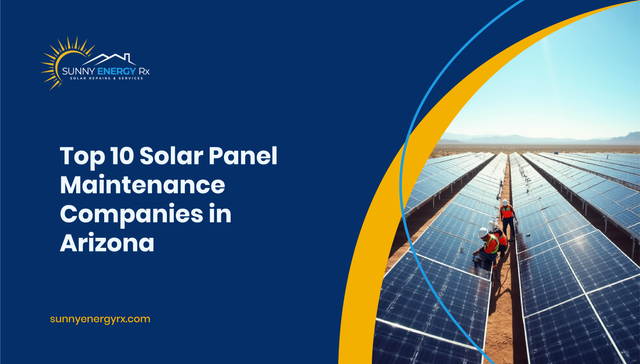Arizona Solar, Built to Last: A Maintenance Audit You Can Actually Use
This blog was originally published on Sunny Energy RX.
Arizona delivers the sunshine every solar owner dreams of, and the wear that most systems aren’t prepared for. Dust builds into a light-scattering film, heat cycles loosen hardware and age electronics, and monsoon bursts push grit where you can’t see it. If you’re sorting through maintenance companies, the smartest move is to think like an auditor: define what “good” looks like, ask for proof, and set a cadence that fits your environment instead of the company’s sales calendar.
Start with an audit mindset
Maintenance that matters isn’t a rinse; it’s a repeatable process with evidence. Ask providers to show you how they verify safety, performance, and roof integrity, not just how they make panels look clean. A credible partner will document before/after conditions, flag emerging issues, and tie each action to measurable output or longevity gains.
The three failure paths in our climate
- Optical loss: fine dust and pollen scatter light long before glass looks dirty.
- Thermal fatigue: triple-digit heat expands and contracts connectors, optimizers, and inverters, loosening terminations and accelerating wear.
- Debris intrusion: monsoon winds drive leaves and grit beneath arrays, trapping moisture, inviting critters, and stressing insulation and drains.
Great maintenance is designed to intercept all three, consistently.
What a high-value visit delivers
A quality service is a sequence: observe → clean → inspect → test → verify → report. You should leave with clarity, not guesses.
- Residue-free cleaning (often deionized water) to avoid mineral spotting that re-attracts grime.
- Mechanical verification: torque on racking, alignment checks, and a close look at flashing and sealants around penetrations.
- Electrical checks: wiring and junction boxes, grounding continuity, hot-spot/corrosion indicators.
- Electronics review: inverter/optimizer logs, communications uptime, firmware status.
- Performance validation: expected vs. actual output for the season, with notes on shading, soiling rate, and any corrective actions.
Expect photos and a plain-language report that explains what was done, what changed, and what to watch.
Pick the right category for your needs
- Original installer: best for continuity when they’re active and responsive; they know your layout and roof details.
- Independent O&M specialist: strongest for mixed brands, legacy gear, or elusive faults; diagnostics and repair depth are their edge.
- Cleaning crew: useful between full services (post-storm or dusty stretches), but not a substitute for electrical and mechanical checks.
Match the provider to the problem you’re solving today, not just to the lowest quote.
Cadence that fits where you live
Most suburban rooftops thrive on an annual comprehensive visit to reset cleanliness, verify hardware, and review production across seasons. Homes near agriculture, construction corridors, or highways and older systems often benefit from a semiannual rhythm. Layer in event-based checks after strong winds or monsoon bursts if your monitoring shows an unexplained dip on otherwise clear days. The goal isn’t more appointments; it’s well-timed ones that prevent compounding issues.
Questions to ask before they leave your driveway
- Can I see your standard inspection checklist and a sample report with photos?
- Who performs the work (employees vs. subcontractors) and what training do they hold?
- How do you diagnose intermittent inverter faults or new error codes?
- What counts as maintenance vs. a billable repair in this plan?
- What’s your typical triage time for summer outages?
Clear, confident answers here usually predict tidy workmanship and fewer surprises on the invoice.
Two-minute owner checks (no ladder)
From the ground, you can time service effectively. Watch for sudden production dips on cloudless days, debris lines at roof edges after storms, critter activity along the roofline, and new shade from growing branches. These are early flags good reasons to schedule a check before minor issues escalate.
How to read quotes in context
Sticker price rarely reveals diagnostic depth. Compare proposals apples to apples on scope (what’s included vs. billed), documentation standards (photos, logs, simple summaries), and response commitments during peak heat. If one bid is dramatically lower, the missing piece is often inspection rigor the very layer that protects output and roof integrity over time.
Bottom line
In Arizona, reliable solar comes from a documented maintenance program tuned to dust, heat, and storms. Choose a provider who proves their process, communicates findings in plain language, and sets a cadence that matches your environment. Do that, and your array will turn desert sun into steady, predictable performance season after season.
For the full context, technical nuances, and expanded examples, explore the complete article hosted by Sunny Energy RX.
